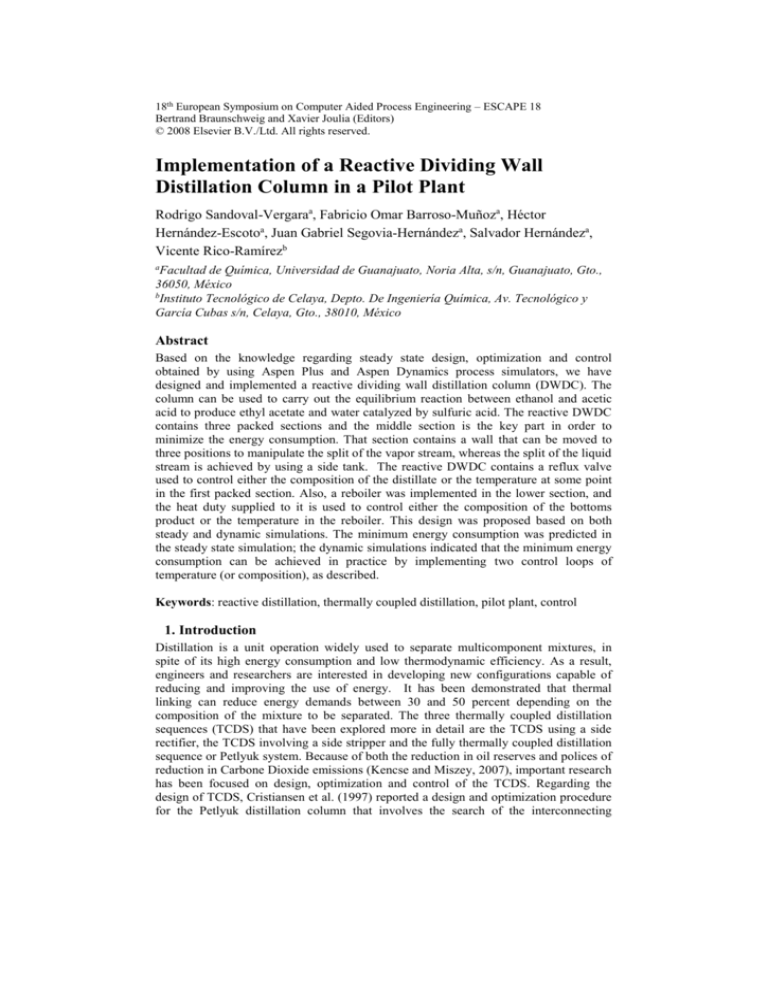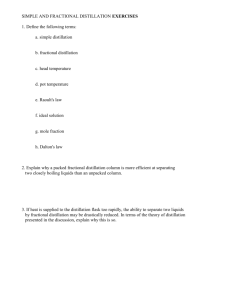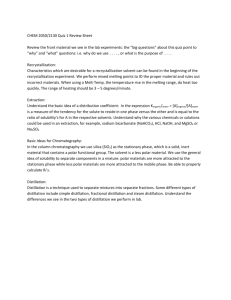
18th European Symposium on Computer Aided Process Engineering – ESCAPE 18
Bertrand Braunschweig and Xavier Joulia (Editors)
© 2008 Elsevier B.V./Ltd. All rights reserved.
Implementation of a Reactive Dividing Wall
Distillation Column in a Pilot Plant
Rodrigo Sandoval-Vergaraa, Fabricio Omar Barroso-Muñoza, Héctor
Hernández-Escotoa, Juan Gabriel Segovia-Hernándeza, Salvador Hernándeza,
Vicente Rico-Ramírezb
a
Facultad de Química, Universidad de Guanajuato, Noria Alta, s/n, Guanajuato, Gto.,
36050, México
b
Instituto Tecnológico de Celaya, Depto. De Ingeniería Química, Av. Tecnológico y
García Cubas s/n, Celaya, Gto., 38010, México
Abstract
Based on the knowledge regarding steady state design, optimization and control
obtained by using Aspen Plus and Aspen Dynamics process simulators, we have
designed and implemented a reactive dividing wall distillation column (DWDC). The
column can be used to carry out the equilibrium reaction between ethanol and acetic
acid to produce ethyl acetate and water catalyzed by sulfuric acid. The reactive DWDC
contains three packed sections and the middle section is the key part in order to
minimize the energy consumption. That section contains a wall that can be moved to
three positions to manipulate the split of the vapor stream, whereas the split of the liquid
stream is achieved by using a side tank. The reactive DWDC contains a reflux valve
used to control either the composition of the distillate or the temperature at some point
in the first packed section. Also, a reboiler was implemented in the lower section, and
the heat duty supplied to it is used to control either the composition of the bottoms
product or the temperature in the reboiler. This design was proposed based on both
steady and dynamic simulations. The minimum energy consumption was predicted in
the steady state simulation; the dynamic simulations indicated that the minimum energy
consumption can be achieved in practice by implementing two control loops of
temperature (or composition), as described.
Keywords: reactive distillation, thermally coupled distillation, pilot plant, control
1. Introduction
Distillation is a unit operation widely used to separate multicomponent mixtures, in
spite of its high energy consumption and low thermodynamic efficiency. As a result,
engineers and researchers are interested in developing new configurations capable of
reducing and improving the use of energy. It has been demonstrated that thermal
linking can reduce energy demands between 30 and 50 percent depending on the
composition of the mixture to be separated. The three thermally coupled distillation
sequences (TCDS) that have been explored more in detail are the TCDS using a side
rectifier, the TCDS involving a side stripper and the fully thermally coupled distillation
sequence or Petlyuk system. Because of both the reduction in oil reserves and polices of
reduction in Carbone Dioxide emissions (Kencse and Miszey, 2007), important research
has been focused on design, optimization and control of the TCDS. Regarding the
design of TCDS, Cristiansen et al. (1997) reported a design and optimization procedure
for the Petlyuk distillation column that involves the search of the interconnecting
2
Sandoval-Vergara et al.
streams of the system. Hernández and Jiménez (1999) presented a design method that
minimizes the energy consumption for a given structure of the Petlyuk distillation
column. Dunnebier and Pantelides (1999) reported a formal procedure based on
mathematical programming for detecting the optimal design of integrated distillation
columns. Also, dynamic studies have been reported for the TCDS; for instance, Jiménez
et al. (2001) compared the theoretical control properties and closed-loop dynamic
responses of conventional and thermally coupled distillation sequences, and they found
that the TCDS schemes presented theoretical control properties and dynamic responses
better that those of the conventional distillation sequences. In the same context, Serra et
al. (2003) compared the controllability of different distillation arrangements and showed
that some different operation conditions to those of the optimum energy consumption
favored the operation of a dividing wall distillation column (DWDC).
The Petlyuk system has been successfully implemented by using a dividing wall inside
a distillation column, the resulting configuration is the dividing wall distillation column.
Practical implementations of the DWDC have reported savings of up to 40% in both
energy and capital costs (Becker et al., 2001; Schultz et al., 2002; Kaibel et al., 2006;
Schultz et al., 2006). Because of polices in process intensification, we are interested in
carrying out reactions in thermally coupled distillation sequences. Based on our
experience regarding steady state design, optimization and control obtained by using
simulations, we have designed and implemented a DWDC to carry out the equilibrium
reaction between ethanol and acetic acid to produce ethyl acetate and water, using
sulfuric acid as catalyst.
2. Base Case: Esterification Process
The process used as base case for the design of the DWDC involves a reactor-column
where ethanol and acetic acid are introduced to the reboiler, and the chemical reaction
proceeds as catalyzed by sulfuric acid according the following reaction at equilibrium.
H 2 SO4
CH 3COOH + C2 H 5OH
H 2O + CH 3COOC 2 H 5
(1)
The distillate is introduced into a decanter tank where two liquid phases are present. The
organic phase is fed into the purification column of the reactor-column system to obtain
a high purity ethyl acetate compound (99.5% weight at) whereas the separated aqueous
phase is fed into a different conventional distillation column to recover the ethanol
which is then returned to the reactor-column. It is important to highlight that two
inconvenient aspects in the operation can be observed in this process: i) the chemical
reaction yield is limited by the thermodynamic chemical equilibrium (presenting a limit
to the ethyl acetate produced) and ii) the system shows the formation of two binary
homogeneous azeotropes, one ternary homogeneous azeotrope and one heterogeneous
binary azeotrope (Figure 1).
3. Steady State and Dynamic Simulation of the Reactive DWDC
Previous to our practical implementation, the design and optimization methods reported
in Hernández and Jiménez (1999) were implemented in a framework involving the
Aspen Plus process simulator. Figure 2 presents the minimization of the energy
consumption of the distillation column; notice that the energy consumption depends
strongly on the values of the interconnecting streams. Appropriate values of the
interconnecting streams are important to obtain the minimum energy consumption in the
Implementation of a Reactive Dividing Wall Distillation Column in a Pilot
3
implemented reactive DWDC. Also, dynamic closed loops were designed for the
reactive DWDC using the Aspen Dynamics process simulator. Two control loops of
temperature were implemented, the first one in the first packed section and the second
one in the reboiler. The reflux rate and reboiler heat duty were selected as manipulated
variables for the first and second control loop, respectively. Figures 3 and 4 show that
the reactive DWDC can achieve positive and negative set point changes in the control
loops of temperature. Also, good dynamic closed responses were obtained for load
rejection; for instance, changes in the feed composition. These results were considered
for the design and implementation of the reactive DWDC.
0.8
0.75
205
185
0.55
190
0.6
195
Process Variable F
Set Point F
200
Figure 2 Energy optimization.
Controller Output
0.65
0.7
210
Figure 1 Ternary map for the system.
0
0.2
0.4
0.6
0.8
Time Hours
1
1.2
1.4
1.6
Figure 3. Dynamic responses for a positive change in the set point (1 °F) in the first control loops.
4. Implementation Issues and Operation of the Reactive DWDC
Figure 5 depicts the DWDC implemented in a pilot plant using stainless steel 316L. We
are interested in the control of the distillate composition, but this task is difficult to
implement in industrial practice; hence, we control the temperature at some point in the
packed section instead. Both of the control objectives require the manipulation of the
4
Sandoval-Vergara et al.
231.5
229.5
Controller Output Btu/hr
1.75e6
1.65e6
230
1.7e6
Process Variable F
Set Point F
230.5
231
1.8e6
1.85e6
reflux ratio in order to set the composition or temperature in their set points. As a result,
a valve was implemented inside the column in order to manipulate the reflux to the
distillation column (Figure 5, element 2).
0
0.2
0.4
0.6
0.8
Time Hours
1
1.2
1.4
1.6
Figure 4. Dynamic responses for a negative change in the set point (1 °F) in the first control
loops.
Several collector and distributor trays were placed in the three packed sections of the
DWDC in order to guarantee homogeneous liquid distribution in the packed bed (Figure
5, elements 10 and 11). Special care needs to be taken between the first and second
packed sections, because a collector tray (Figure 5, element 11) is needed in the bottom
of the first packed bed in order to send the liquid to a side tank. This device plays an
important role because during the steady state design and optimization, since it is
fundamental to detect the optimal splits of liquid and vapor in the middle section of the
DWDC to guarantee the optimal energy consumption in the reboiler. In practice, it is
difficult to manipulate the splits of vapor; for that reason, the side tank (Figure 5,
element 4) has been implemented to split the liquid to both sides of the wall in the
middle section of the distillation column and to extract the water decanted.
The DWDC contains three packed sections of Teflon rasching super-rings. In the
middle section (Figure 5, elements 6 and 7) of the distillation column, a wall (Figure 5,
element 5) was implemented so that it can be moved to three positions to manipulate the
split of the vapor stream. This is the key packed section in the energy-performance of
the DWDC, because the feed is introduced in one side (equivalent to the prefactionator
in the Petlyuk system, Figure 5, element 7) and in the other one (Figure 5, element 6) a
liquid side product is obtained (the side product stream in the main column of Petlyuk
systems). As it can be seen, this section needs collector and distribution trays in the feed
and side stream points.
The first and third packed sections are similar to those of a conventional distillation
column, and only distributor and support trays are required for the operation of the
DWDC. A reboiler (Figure 5, element 9) that can be charged with the reacting mixture
in the batch operation fashion was placed at the end of the third packed section. Finally,
several thermocouples were implemented in the DWDC to register the temperature
Implementation of a Reactive Dividing Wall Distillation Column in a Pilot
profiles. The future research work is focused on the experimental study of the
hydraulics, steady state and closed-loop dynamics.
1
2
10
3
11
4
13
11
10
5
10
13
12
7
10
6
11
1
2
3
4
5
6
7
8
9
12
13
10
11
Condenser
Reflux valve
First packed section
Side tank splitter
Dividing wall
Second packed section (side product)
Second packed section ( feed)
Third packed section
Reboiler
Side product collector
Side tanks for distillate
Distributor tray
Collector tray
8
9
Figure 5 DWDC implemented in the pilot plant (patent in process).
5
6
Sandoval-Vergara et al.
5. Conclusions
We have designed and implemented a reactive divided wall distillation column for the
production of ethyl acetate from acetic acid and ethanol. Important aspects derived from
steady state simulation were considered; for instance, a side tank was implemented in
order to split the liquid to both sides of the wall and a moving wall inside the column
that allows to fix the split of the vapor stream. The dynamic simulations indicate that it
is possible to control the composition of the top and bottoms products or two
temperatures by manipulating the reflux rate and the heat duty supplied to the reboiler,
respectively. The implementation of the reactive divided wall distillation columns takes
into account important aspects like process intensification, minimum energy
consumption and reduction in Carbon Dioxide emission to the atmosphere.
Acknowledgements
We acknowledge the financial support provided by Universidad de Guanajuato,
CONACyT and CONCyTEG (México).
References
A.C. Christiansen, S. Skogestad, K. Lien, 1997, Complex Distillation Arrangements: Extending
the Petlyuk Ideas. Comput. Chem. Engng., 21, S237.
G. Dunnebier, C. Pantelides, 1999, Optimal Design of Thermally Coupled Distillation Columns.
Ind. Eng. Chem. Res.,38, 162.
H. Becker, S. Godorr, H. Kreis, 2001, Partitioned distillation columns –why, when and how,
Chem. Eng. 108, 68.
S. Hernández, A. Jiménez, 1999, Design of Energy-Efficient Petlyuk Systems. Comput. Chem.
Eng., 23, 1005.
A. Jiménez, S. Hernández, F. A. Montoy, M. Zavala-García, 2001, Analysis of Control Properties
of Conventional and Nonconventional Distillation Sequences. Ind. Eng. Chem. Res., 40, 3757.
M.A. Schultz, D.G. Stewart, J.M. Harris, S.P. Rosenblum, M.S. Shakur, D.E. O’Brien, 2002,
Reduce costs with dividing-wall columns, Chem. Eng. Prog., 98, 64.
B. Kaibel, H. Jansen, E. Zich, Z. Olujic, 2006, Unfixed Dividing Wall Technology for Packed and
Tray Distillation Columns, In Distillation and Absorption ‘06, IChemeE Symp. Series No. 15,
252.
H. Kencse, P. Mizsey, 2007, Comprehensive Process Investigation Methodology for EnergyIntegrated Distillation, In proceedings of 17th European Symposium on Computer Aided Process
Engineering (ESCAPE), Elsevier, 24, 883.
M.A. Schultz, D.E. O’Brien, R.K. Hoehn, C.P. Luebke, D.G. Stewart, 2006, Innovative
Flowscheme using Dividing Wall Columns, In proceedings of 16th European Symposium on
Computer Aided Process Engineering (ESCAPE) and 9 th International Symposium on Process
Systems Engineering (PSE), Elsevier, 21, 695.
M. Serra, A. Espuña, L. Puigjaner, 2003, Controllability of different multicomponent distillation
arrangements, Ind. Eng. Chem. Res., 42, 1773.








